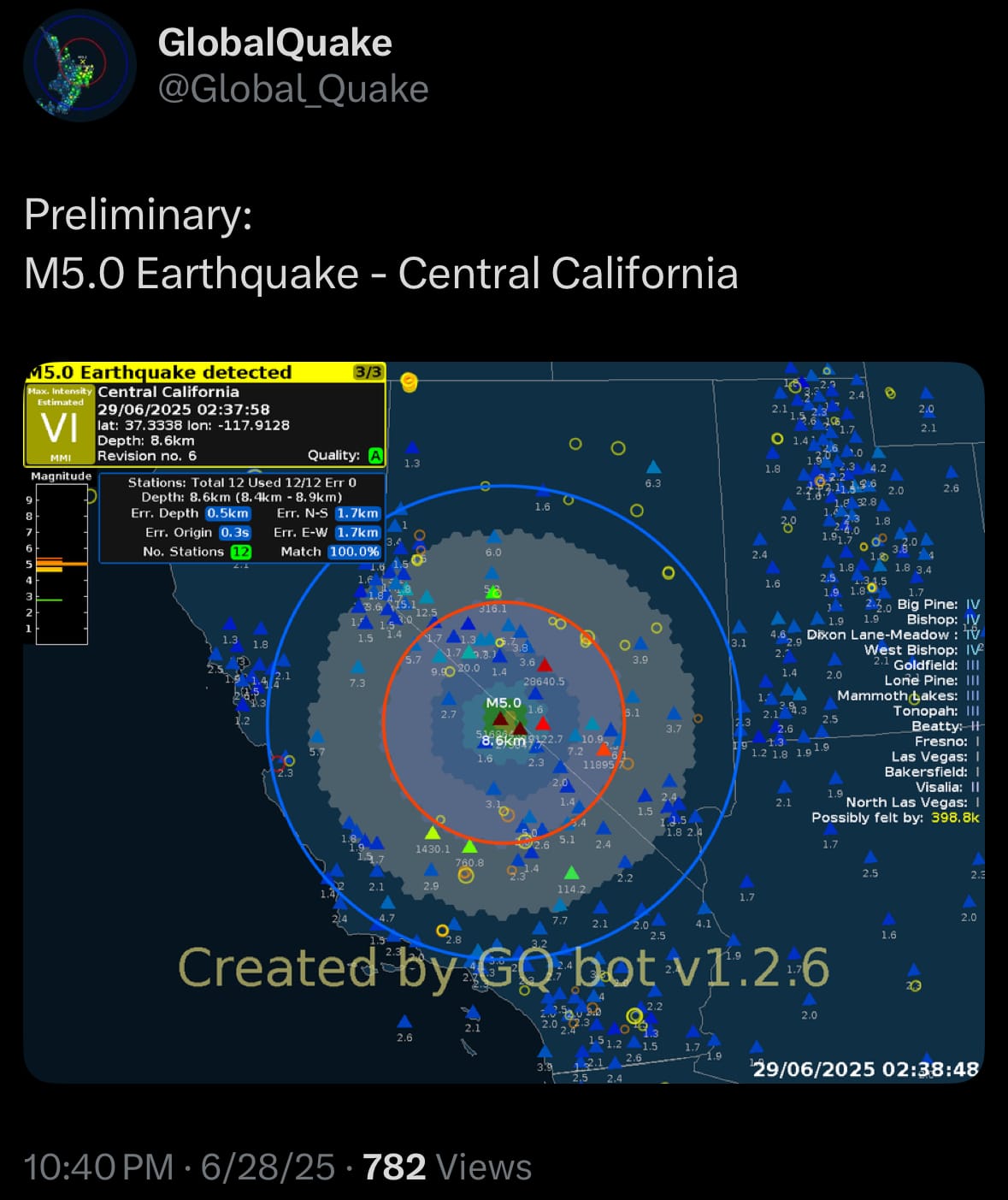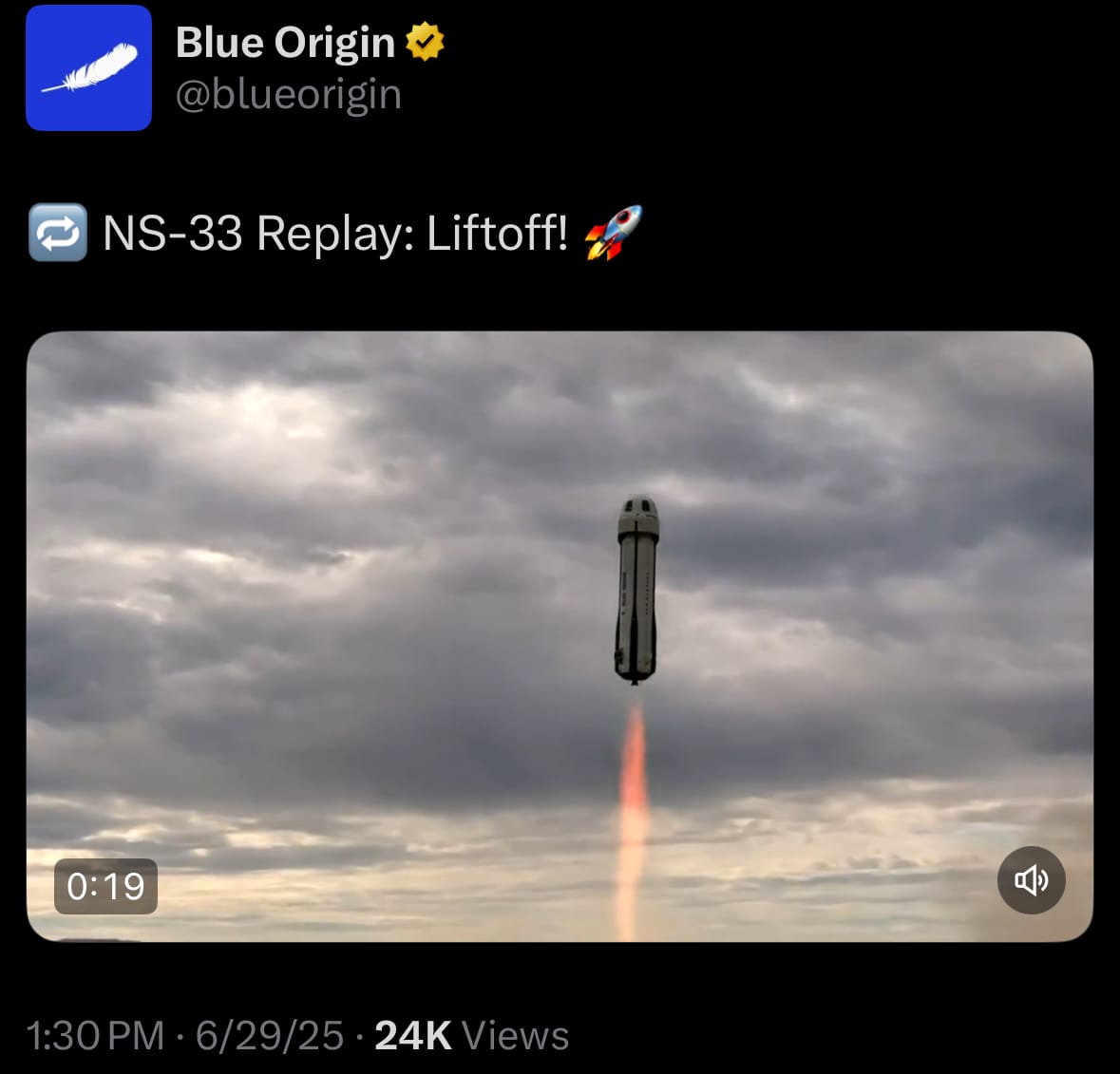Monday☕️

Economics & Markets:
- Yesterday‘s commodity market:

- Yesterday’s crypto market:

Geopolitics & Military Activity:
- On June 29, 2025, Russia launched a massive air assault on Ukraine, deploying 477 drones and 60 missiles, including 41 Kh-101 cruise missiles, from bases in Kursk, Shatalovo, Oryol, Bryansk, Millerovo, and Crimea. Ukraine’s Air Force reported this as the largest combined drone and missile strike since the war began, targeting regions including Lviv, Zaporizhzhia, Cherkasy, Mykolaiv, Kremenchuk, Ivano-Frankivsk, Poltava, and Shakhtars’k in Dnipropetrovsk.

- Specific strikes involved eight Kh-101 missiles near Drohobych, three near Kremenchuk, three Onyx missiles on Mykolaiv City, five Kinzhal ballistic missiles on Kremenchuk, and one Iskander-M missile on Shakhtars’k. Ukrainian defenses downed 211 drones and 33 cruise missiles, achieving a 22.9% missile interception rate, with others jammed or lost. The attack damaged civilian infrastructure and injured six people, including a child, in Cherkasy.

Environment & Weather:
- On June 29, 2025, heavy rainfall triggered severe flooding at Ayub Teaching Hospital in Abbottabad, Pakistan, forcing hospital staff to relocate patients to the roadside as water overwhelmed the facility. News reports indicated that floodwaters inundated the hospital’s corridors and wards, disrupting operations at this 1,460-bed tertiary care center, a critical healthcare provider for northern Pakistan. The flooding was part of widespread flash floods across Khyber Pakhtunkhwa, with The Guardian and 24 News HD reporting at least 32 deaths due to rain-related incidents in the region. This event highlighted the hospital’s vulnerability to extreme weather, a challenge compounded by the intense monsoon season affecting the area.

- The incident underscored broader infrastructure challenges in Pakistan’s healthcare system during severe weather events. A Dawn News report from June 27, 2025, had noted rising water levels in Abbottabad’s rivers and canals, signaling heightened flood risks. Historical reports, such as a 2022 flood event at the hospital, suggest recurring issues with drainage and flood management. As of June 30, 2025, no official statements from the hospital or local authorities have detailed the full extent of the damage or the status of relocated patients.


Space:
- On Saturday, June 28, 2025, the first space launch of the day was SpaceX’s Falcon 9 Block 5 rocket, carrying the Starlink Group 10-34 mission from Space Launch Complex 4E (SLC-4E) at Vandenberg Space Force Base, California. The payload consisted of a batch of Starlink satellites deployed into low Earth orbit (LEO) to support SpaceX’s global broadband internet constellation, aimed at providing high-speed connectivity worldwide. The Falcon 9, a two-stage rocket with a reusable first stage, is designed to deliver payloads efficiently, with the booster typically landing on a droneship for reuse. Later that morning, Rocket Lab launched its Electron rocket from Launch Complex 1B (LC-1B) at Māhia Peninsula, New Zealand, for the “Symphony in the Stars” mission. The payload was a single communications satellite, likely EchoStar’s Lyra Block-1, placed into a 650 km sun-synchronous orbit to enable Internet-of-Things (IoT) connectivity. The Electron rocket is a small-lift vehicle optimized for precise orbital placements, catering to commercial clients.

- The afternoon of June 28 saw two additional orbital launches. Mitsubishi Heavy Industries (MHI) launched the H-IIA F50 rocket from Launch Area Y1 (LA-Y1) at Tanegashima Space Center, Japan, deploying the GOSAT-GW (Greenhouse Gases Observing Satellite - Global Water) for the Japan Aerospace Exploration Agency (JAXA). This satellite, orbiting at 666 km in a sun-synchronous orbit, is equipped to monitor greenhouse gases (CO2, CH4, NO2) and water cycles, providing data for climate and environmental research. The launch marked the final flight of the H-IIA rocket, concluding its operational history as Japan transitions to newer launch vehicles. Subsequently, SpaceX conducted its second launch of the day, deploying Starlink Group 15-7 via another Falcon 9 Block 5 from Vandenberg’s SLC-4E. This mission delivered 26 Starlink satellites into LEO to enhance the constellation’s global internet coverage, with the reusable first stage designed to land on a droneship, aligning with SpaceX’s standard operations.

- On Sunday, June 29, 2025, Blue Origin’s New Shepard rocket launched the NS-33 mission from Launch Site One in West Texas. The suborbital flight carried six passengers—Allie Kuehner, Carl Kuehner, Leland Larson, Freddie Rescigno, Jr., Owolabi Salis, and James Sitkin—who experienced several minutes of weightlessness after crossing the Kármán line at approximately 100 km altitude. The New Shepard, a reusable vehicle with a booster and crew capsule, is built for space tourism and scientific experiments, with the booster landing vertically and the capsule returning via parachute. This mission, Blue Origin’s 13th crewed flight and fifth New Shepard launch of 2025, provided passengers with a view of Earth and a brief microgravity experience, contributing to the expansion of commercial space tourism.

Statistic:
- Largest public construction companies by market capitalization:
- 🇫🇷 Vinci: $82.12B
- 🇮🇳 Larsen & Toubro: $59.22B
- 🇺🇸 D. R. Horton: $39.53B
- 🇪🇸 Ferrovial: $38.24B
- 🇨🇳 China State Construction Engineering: $33.30B
- 🇺🇸 Lennar: $28.91B
- 🇺🇸 Emcor: $23.74B
- 🇺🇸 NVR: $21.56B
- 🇯🇵 Daiwa House: $21.28B
- 🇺🇸 PulteGroup: $21.14B
- 🇨🇳 China Railway Group: $18.12B
- 🇨🇳 China Communications Construction: $17.68B
- 🇪🇸 Grupo ACS: $17.22B
- 🇫🇷 Bouygues: $17.12B
- 🇩🇪 Hochtief: $14.71B
- 🇯🇵 Sekisui House: $14.32B
- 🇨🇳 China Railway Construction: $14.29B
- 🇫🇷 Eiffage: $13.32B
- 🇯🇵 Kajima: $12.23B
- 🇨🇳 Sichuan Road and Bridge Group (SRBG): $12.09B
- 🇨🇦 AtkinsRéalis: $11.92B
- 🇨🇳 Power Construction Corporation of China: $11.72B
- 🇺🇸 Toll Brothers: $11.22B
- 🇯🇵 Obayashi: $10.66B
- 🇦🇹 Strabag: $10.63B
History:
- Flood tracking technology has evolved significantly from ancient times to the modern era. In ancient civilizations, such as those in Mesopotamia and Egypt around 3000 BC, flood monitoring relied on rudimentary methods like observing river levels with marked stones or simple gauges along riverbanks. The Nile River’s annual flooding, critical for agriculture, was tracked using nilometers—stone structures or wells with calibrated markings to measure water levels. These early systems allowed communities to predict flood timing and prepare for agricultural cycles, but they were limited to local observations, lacked precision, and offered no real-time warnings. By the Middle Ages, more structured approaches emerged, such as manual record-keeping of flood events in Europe and Asia, but these were still reactive and heavily dependent on human observation, with no systematic way to forecast or communicate flood risks across regions.
- In the modern era, flood tracking has transformed with advancements in technology, culminating in systems like Google’s Flood Monitoring System. The 19th and 20th centuries saw the introduction of mechanical rain gauges, stream gauges, and early meteorological networks, enabling more accurate data collection and regional flood predictions. By the late 20th century, satellite imagery and radar systems revolutionized flood monitoring, providing real-time data over large areas. Google’s system, launched in the 2010s and expanded through 2025, integrates artificial intelligence, satellite data, weather models, and ground-based sensors to deliver near-real-time flood forecasts and alerts globally. Covering over 80 countries, it uses machine learning to predict flood risks with high accuracy, providing actionable insights via Google Maps and alerts, a far cry from the passive, localized methods of ancient times. This system exemplifies how technology has shifted flood tracking from manual observation to predictive, scalable, and accessible solutions.
Image of the day:

Thanks for reading!
Earth is complicated, we make it simple.
Click image to view the Earth Intelligence System:



Support/Suggestions Email:
earthintelligence@earthintel.news




